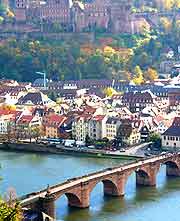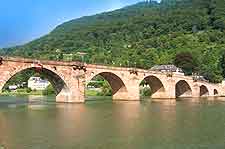Heidelberg History Facts and Timeline
(Heidelberg, Baden-Württemberg, Germany)

Heidelberg's history dates back to the 5th century BC, when a group of Celts moved into the area. They built a fortress and church on the Heiligenberg, also known as 'Saint's Mountain'.
In 80 AD, the Romans arrived, setting up a permanent settlement on the bank of the Neckar River. A town grew up around the military camp and in the 8th century AD, historical records mention the village of Bergheim for the first time. Bergheim is today a district of modern Heidelberg.
From Medieval to Renaissance Times
Medieval Heidelberg history dates to the 12th century and the founding of a religious community here. In 1196, it is mentioned in records found in Schönau Abbey. The origins of Heidelberg Castle can be traced back to an early fortress on the site. In 1225, the castle came under the control of Louis I, the Duke of Bavaria. In 1303, another castle was built to defend the area and the ruins can still be seen today.
In 1386, Prince Elector Ruprecht I founded Heidelberg University. It was the third university to be founded within the Holy Roman Empire after
Prague and
Vienna, and today remains the oldest in Germany. It's thought that it owed its early success to an outbreak of plague in the nearby university city of Prague. Seeking an alternative place of education, many students opted for Heidelberg because it was considered far enough away from the source of contagion. In 1400, the Heiliggeistkirche, or Church of the Holy Ghost, was built in the old market place. It was followed, in 1421, by the oldest public library in Germany.
In the mid-16th century, Prince Elector Otto Heinrich set about transforming the castle into a splendid building styled on Renaissance architecture. It is widely regarded as being one of the earliest German examples. Later, the castle was further extended, with the addition of its famous garden, gate and 'English Building'. Whilst the university managed to initially remain unaffected by the Reformation, it finally succumbed in 1556, when it was turned into a Protestant institution. In 1563, the university's Faculty of Theology contributed to the writing of the Heidelberg Catechism, essentially the textbook for the reformed faith in Germany.

Castle Attack and Peace Treaty
In 1622, Heidelberg Castle came under attack from General Tilly, a commander of the Holy Roman Emperor. That same year, the contents of the city's world-renowned library were confiscated and taken to the Vatican. Then, in 1688, French troops marched on Heidelberg and captured its castle. They left the following year, but not before they had destroyed its fortifications to prevent them being used in future attacks.
It wasn't until 1697 and the signing of a peace treaty that work on rebuilding Heidelberg could begin in earnest. This time, the new Baroque style of architecture was adopted. In the 18th century, Prince Elector Karl Theodor attempted to renovate the castle. However, in 1764, lightning struck the building, burning it to the ground and rendering it uninhabitable. Needless to say, after several further ill-fated attempts, he gave up.
History from the 19th Century to Modern Times
The reorganisation of German states in 1803 was a turning point for the city's fortunes. The city was placed under the control of the Grand Duchy of Baden and its university became a state-owned institution. As a seat of learning, Heidelberg attracted many famous visitors. In 1880, the American author Mark Twain travelled here and, as a result, wrote 'A Tramp Abroad', a non-fiction travel book in which the city was to feature.
During World War Two, Heidelberg managed to survive with relatively little damage. This is largely because US forces took control of the city under General Patton and used it as their headquarters. Huge barracks were built in the southern part of the city at this time.
In the 1970s, work began on modernising the city, including the pedestrianisation of its main street. In 1986, the Palatinate Library's contents were finally returned to Heidelberg as part of the 600th anniversary celebrations of the city's acclaimed university. It remains an important university city to this day and around a quarter of its population are students. It also has a large proportion of American residents.
 Heidelberg's history dates back to the 5th century BC, when a group of Celts moved into the area. They built a fortress and church on the Heiligenberg, also known as 'Saint's Mountain'.
Heidelberg's history dates back to the 5th century BC, when a group of Celts moved into the area. They built a fortress and church on the Heiligenberg, also known as 'Saint's Mountain'.